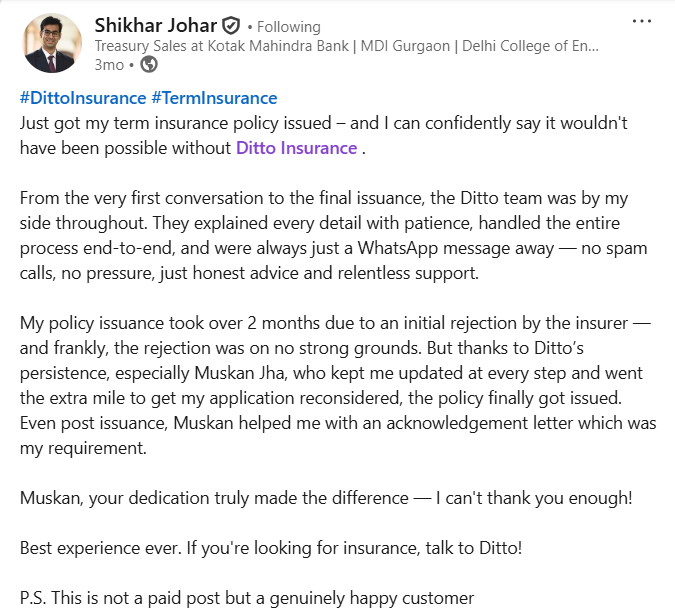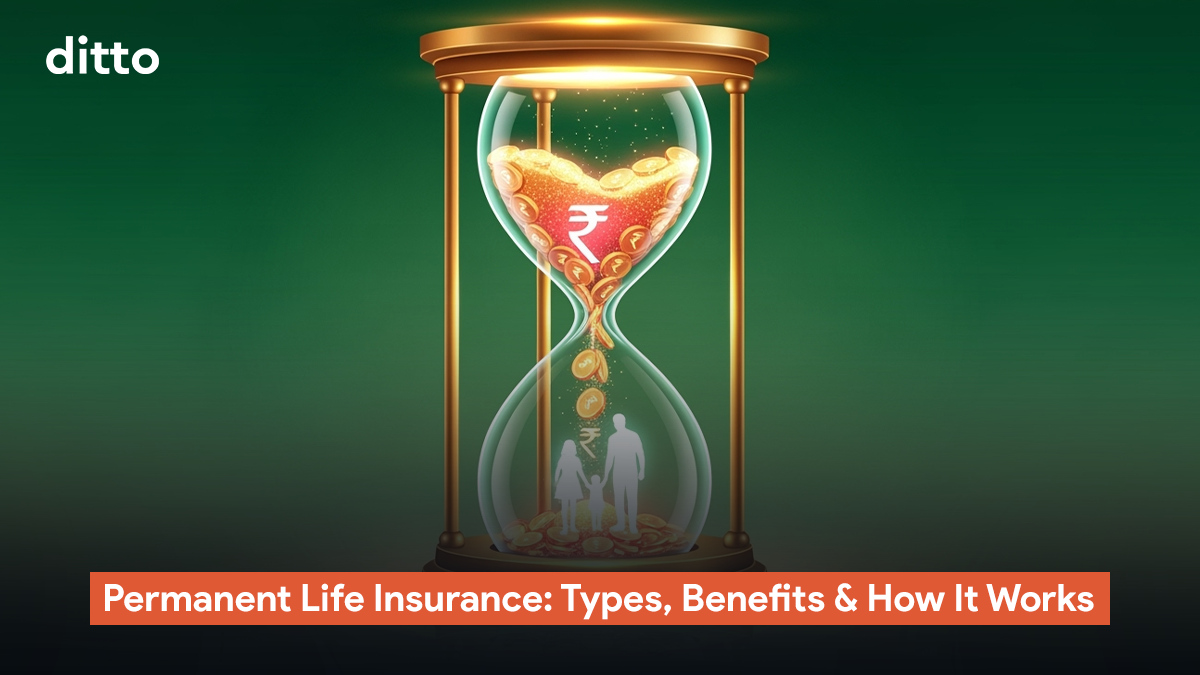|
What is Permanent Life Insurance? Permanent life insurance is a type of policy that covers you for your entire life, not just a fixed term. It ensures a death benefit for your family and often builds a tax-deferred cash value. You can use this cash value during your life for loans, emergencies, or other financial needs. |
Permanent Life Insurance: Introduction
In India, term life insurance is the most popular choice because it offers high coverage at an affordable cost. It’s designed to protect your family during the critical earning years, ensuring financial security if something unexpected happens. But what if you want coverage that lasts your entire lifetime, not just for a fixed term?
That’s where permanent life insurance comes in. Unlike term plans, permanent policies continue for your whole life (often up to age 100) as long as you keep paying premiums. They guarantee a payout to your beneficiaries.
In this guide, we’ll walk you through everything you need to know about permanent life insurance in India: how it works, the different types, the pros and cons, and who should consider it. By the end, you’ll be able to decide if it’s the right fit for your family’s long-term security.
In case you’re unsure which plan fits your needs, Ditto can help. Book a FREE consultation with our experts today and get personalized guidance to choose the right plan for you and your family.
What is Permanent Life Insurance?
Unlike term life insurance, which only covers you for a specific period (like 10, 20, or 30 years), permanent life insurance enables your beneficiaries to receive a payout no matter when you pass away.
In the Indian insurance market, the phrase "permanent life insurance" is not commonly used in product brochures or regulations. Instead, insurance companies offer similar coverage under names like Whole Life Plans. If you want the closest equivalent to permanent life insurance in India, it is Whole Life Insurance.
Whole Life Insurance in India provides coverage for the insured's entire life, often up to age 99 or 100. It pays the sum assured to the family upon the death of the policyholder, whenever it occurs. Unlike endowment plans, whole life insurance typically does not carry a maturity value, but some policies do build a surrender value or offer bonuses.
Now, here’s where permanent life insurance becomes more than just protection. These plans don’t just pay out when you’re gone, they also build something extra while you’re alive: a cash value that grows over time and can be tapped into if needed.
How does the Cash Value in Permanent Life Insurance work?
A vital feature of permanent life insurance is the cash value component. A part of your premium—after deducting charges—is allocated to a savings or investment portion within the policy.
In traditional plans like Whole Life or Endowment, this portion is not explicitly fixed and may be lower in early years due to commissions and expenses, generally estimated around 20–30% and grows later in policy’s life. This cash value grows over time, usually at a guaranteed rate in Whole Life and Endowment Plans, often around 4–6% annually when combining guaranteed interest and potential bonuses.
In ULIPs, about 85–95% of the premium minus initial allocation charges is invested, but initial charges may reduce this percentage initially. Their cash value growth is linked to market performance, with expected long-term returns around 10–12% for equity-oriented funds, though these are projections and not guaranteed, reflecting market risk. One key benefit is that this growth is tax-deferred, meaning you do not pay taxes on gains within the policy until you withdraw or surrender it.
You can also take a loan against the cash value once the policy has been active for a certain number of years (often three years). This can provide liquidity during financial emergencies, big purchases, or other needs. However, any unpaid loan amount plus interest will reduce the death benefit your beneficiaries receive.
How Does Permanent Life Insurance Work?
When you buy a permanent life insurance policy, you agree to pay premiums regularly, usually every month or year. Your premium payment is split into two parts:
- One part covers the cost of insurance, called mortality charges. This pays for your life cover or death benefit.
- The other part goes into a savings pool within your policy. This is often called the “surrender value” or “paid-up value” in India. It is your policy’s internal savings that grow over time.
If you have a “participating” or “with-profit” policy, your insurer may declare bonuses or additions every year. These bonuses increase your policy’s overall value.
Here’s a simple formula for how the policy value grows over time:
Policy Value = Accumulated Premiums + Bonuses - Charges
If you decide not to continue paying premiums and surrender the policy early, you can receive the surrender value, which is the savings you have built up minus any charges or penalties.
If you continue premium payments throughout the policy term, this value grows steadily over the years, potentially for decades.
After the policy has been active for about three years, you can borrow against the accumulated cash value. These loans can be useful in emergencies or for large expenses, but any unpaid balance with interest will be deducted from the eventual death benefit.
What Are the Different Types of Permanent Life Insurance?
When we talk about permanent life insurance in India, there are a few common types you’ll come across. These plans are designed to give you lifelong protection, along with a savings or investment component in many cases. Let’s break down the main types in simple terms:
1. Whole Life Insurance (Traditional)
Whole life insurance is the classic permanent life insurance that covers you for your entire life, usually up to age 99 or 100. Your premiums stay fixed, which means the amount you pay doesn’t change over time. A part of your premium builds a savings fund inside the policy, often known as the cash value.
Some whole life plans in India, like LIC’s Jeevan Umang or Jeevan Utsav, also add bonuses based on the insurer’s profits. For instance:
- Jeevan Umang pays you a guaranteed 8% of the sum assured every year after you finish paying premiums.
- Jeevan Utsav lets you withdraw 10% of the sum assured yearly or leave it in a flexi account to earn interest and grow your savings further.
Both policies provide a death benefit to your family if something happens before maturity, and you can even take loans against the accumulated policy value for emergencies.
2. Endowment Plans
Though technically different from permanent insurance, many endowment plans in India behave like long-term savings and insurance combos. You pay premiums for a fixed term, and if you survive the term, you get a lump sum maturity payout. If you pass away during the term, your nominee gets the sum assured plus any bonuses.
Endowment plans are popular for disciplined savings and are often used for specific goals like funding a child’s education. For example, ICICI Pru Gold Plan offers both protection and savings benefits.
3. Unit Linked Insurance Plans (ULIPs)
ULIPs mix life insurance with market investments. A part of your premium pays for the life cover, while the rest gets invested in equity or debt funds based on your risk appetite. ULIPs have the potential for higher returns but come with investment risks.
Some ULIP plans have features similar to whole life insurance which allows you to stay covered for a very long time while your money grows in the market. For example, HDFC Life’s Click2Wealth ULIP with its Golden Years Benefit option provides coverage up to age 99 along with potential growth in fund value.
4. Whole Life Term Plans
Recently, some insurers offer term insurance plans that last up to age 99 or 100. While these don’t build savings like whole life policies, they offer lifetime coverage at premiums lower than traditional whole life plans.
These “whole life term plans” can be ideal if you want the peace of mind of lifelong cover without paying for an investment component. If you’re looking for lifelong coverage without investing, check out this guide on 99-year term insurance plans and whether they might be right for you.
| Did You Know? According to IRDAI’s master circular on life insurance products, any policy without a fixed term that ends only on the death of the life assured, or offers coverage at least up to age 80, is classified as a Whole Life policy. You will find this nomenclature mentioned in whole life plans usually. |
So, Which One Should You Choose?
- If you want stable, guaranteed lifelong protection with some savings growth, whole life insurance is a good pick.
- If you’re comfortable with market risk for potentially higher returns, consider ULIPs.
- If you want affordable lifelong protection without savings, a whole life term plan is worth exploring.
Pros and Cons of Permanent Life Insurance
Advantages of Permanent Life Insurance:
- Lifelong coverage: Whole life plans provide protection up to age 99–100, ensuring your family receives a payout regardless of when death occurs.
- Cash value growth: Part of your premium builds a tax-deferred savings component that grows over time, often with bonuses.
- Loan facility: After a few years, you can borrow against the cash value for emergencies; though unpaid loans reduce the death benefit.
- Fixed premiums (for traditional whole life): In most traditional whole life policies, your premiums remain the same throughout the paying term. This predictability makes it easier to budget over the long run.
- Tax Benefits: One of the advantages of permanent life insurance is that premiums paid are eligible for tax deductions under Section 80C (under old tax regime) of the Income Tax Act (up to ₹1.5 lakh per year). The death benefit is tax-free under Section 10 (10D), and the policy’s cash value grows without being taxed.
- Estate planning benefits: Whole life insurance can also play a role in succession planning. It ensures your dependents or heirs receive a guaranteed payout and can help cover liabilities, provide inheritance, or even create a legacy gift.
Cons of Permanent Life Insurance:
- Higher premiums than term life: Whole life and similar plans are significantly costlier compared to term insurance, since they promise lifelong cover and include a savings element.
To better understand how permanent life insurance compares to term life insurance, you might find this detailed comparison helpful: What is the difference between term and whole life insurance? - Policy complexity: Endowment plans, ULIPs, and participating whole life plans may come with terms like bonuses, surrender values, or fund switches. For someone new to insurance, these can be difficult to fully understand.
- Loans or withdrawals reduce death benefit: If you take a loan and don’t repay it, the amount (plus interest) will be deducted from the death benefit your nominee receives. Similarly, partial withdrawals can lower the policy value.
- Slower growth compared to investments: While cash value and bonuses accumulate, they usually grow at a modest rate. Other investment avenues like mutual funds or PPF may offer higher returns, though without the insurance cover.
- Takes time to build value: In the initial years, the surrender value is quite low. It generally takes consistent long-term premium payment before the savings element becomes meaningful.
Who Can Consider Permanent Life Insurance?
Here’s who might want to consider a permanent life insurance policy:
- People Planning for Long-Term Financial Security: If you want insurance that lasts your whole life and not just for a few years, permanent life insurance is a good choice.
For example, if you are planning for a dependent like a special needs child who will need financial support throughout their lifetime, lifelong coverage ensures there will always be a safety net in place.. - Those who want insurance + savings: Endowment plans, participating whole life, and ULIPs provide a mix of insurance and savings/investment. These work well for people who prefer disciplined, long-term wealth building.
- Families thinking about estate or legacy planning: Whole life policies are useful for passing wealth to children, supporting dependents, or even making donations to charities after your lifetime.
Why Choose Ditto for Term Insurance?
At Ditto, we’ve assisted over 7,00,000 customers with choosing the right insurance policy. Why customers like Srinivas below love us:

✅No-Spam & No Salesmen
✅Rated 4.9/5 on Google Reviews by 15,000+ happy customers
✅Backed by Zerodha
✅Dedicated Claim Support Team
✅100% Free Consultation
Conclusion
Permanent life insurance, in the Indian market, largely takes the form of whole life plans, endowment policies, money-back plans, or ULIPs. These policies not only provide lifelong protection but also help you build savings or investments alongside insurance. They give peace of mind knowing your family will have financial security whenever the inevitable happens.
The right choice depends on your needs and budget. Whole life plans offer stability and guaranteed cover, endowment plans are suited for goal-based savings, ULIPs work for those comfortable with market risks, and whole life term plans provide lifetime coverage at affordable rates without a savings element.
If affordability is a concern, some people also combine term insurance for pure protection with a smaller coverage permanent plan for lifelong benefits.
In case you’re unsure which plan fits your needs, Ditto can help. Book a FREE consultation with our experts today and get personalized guidance to choose the right plan for you and your family.
FAQs About Permanent Life Insurance
Can I convert my term insurance to permanent life insurance?
In India, term insurance usually cannot be converted into permanent plans like Whole Life or Endowment. Some insurers, however, offer limited renewal or extension features at maturity. For example, HDFC Life’s Click 2 Protect Supreme lets you extend the term at the end of the policy, but the new premium will depend on your age at that time and certain conditions apply.
How long do I need to pay premiums for permanent life insurance?
It depends on the plan. Some require premiums throughout your lifetime, while others offer limited pay options (like 10, 15, or 20 years). After completing the premium term, the policy remains active for life.
Is permanent life insurance a good investment?
Permanent life insurance is best seen as protection with savings. Traditional plans like whole life or endowment provide steady but modest returns, while ULIPs offer market-linked growth (with higher risk). For pure investments, products like PPF or mutual funds may give better returns.
Can I borrow against the cash value?
Yes. Once your policy builds up cash/surrender value (usually after 2–3 years), you can take a loan against it. Remember, unpaid loans plus interest will reduce the final payout to your family.
Why does permanent life insurance cost more than term life insurance?
Permanent life insurance costs more because it covers you for your entire life, whereas term life insurance only covers you for a fixed period. The insurer assumes a higher risk for permanent policies, as the payout is guaranteed eventually. Also, permanent life insurance policies build cash value and have higher administrative costs and investment management fees, all of which increase the premium.
Is There a Tax Benefit with Permanent Life Insurance?
Yes. Premiums paid for permanent life insurance are eligible for tax deduction under Section 80C of the Income Tax Act (old regime) up to ₹1.5 lakh per year. The death benefit received by your nominee is tax-free under Section 10(10D). Also, the savings/cash value inside the policy grows tax-deferred.
Last updated on:







